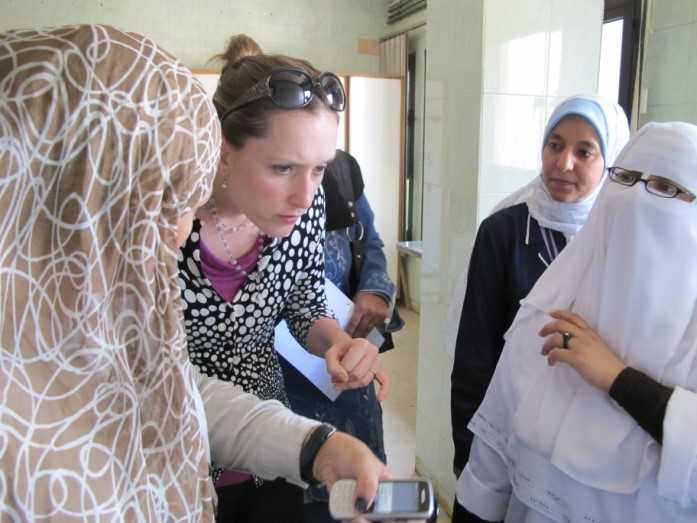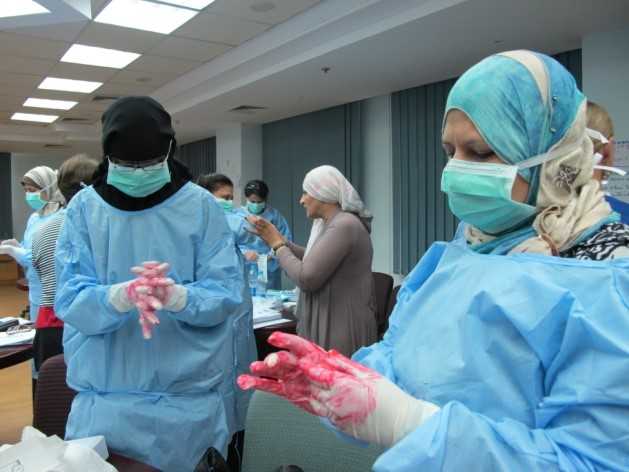Global Disease Detection Stories: Protecting the Power of Antibiotics—Lessons from Egypt
Cultural roadblocks can stand in the way of addressing the danger of antimicrobial resistance. In Egypt, barriers are coming down thanks to a national program that works with hospitals and communities to address healthcare-associated infections and change the way antibiotics are used.

Infection prevention and control (IPC) specialists travel in Egypt .
“The world is heading towards a post-antibiotic era, in which common infections and minor injuries, which have been treatable for decades, can once again kill.” – World Health Organization (WHO)
If nothing is done to stop the rise of antimicrobial resistance, we may soon lose our power to treat even common diseases. Despite this frightening reality, cultural roadblocks can sometimes stand in the way of addressing the danger. Egypt has faced many such roadblocks: people misusing antibiotics; laboratories lacking equipment to identify the source of disease; physicians lacking trust in lab results or technology; and widespread taboos against collecting and sharing personal health data.
Dr. Maha Talaat, who has led infection control and prevention work in Egypt for over a decade as part of the Centers for Disease Control and Prevention (CDC) Global Disease Detection (GDD) program, recognized the need for a national program to address healthcare-associated infections (HAIs) and antimicrobial resistance. She and her team are finding ways to overcome barriers, working closely with hospitals and communities to change the way antibiotics are used.
Step One: Start counting
In Egypt, no one knew exactly how widespread or what the main causes of drug resistant infections were. “Unless you can actually identify what you’re treating, it’s hard to know what your target should be,” explains Lauri Hicks, a CDC medical epidemiologist who consulted on the new program. Maha’s team began by working with experts from Egypt, the U.S., Europe, and the World Health Organization (WHO) to build a plan to identify hospitals with the highest infection risk, and then work with them to reduce it based on what the data revealed.
Recognizing that HAIs are a significant source of antibiotic resistant bacteria, the team began looking for active infections in intensive care units in hospitals around Egypt, working with labs to help identify pathogens and using smart devices to gather necessary patient information. They started small in 2010, but the program now reaches 44 hospitals with over 1500 ICU beds, with more added every day.

A consultant conducts a training in Egypt.
Step Two: Make it possible
At first, the program was met with skepticism from physicians who didn’t trust the use of smart devices to gather data. However, nurses were excited to have state-of-the-art technology in their hands, where they could enter and access patient information at the push of a button. ”People get tired of paper,” notes Maha. Devices were programmed first in English and then translated into Arabic, making them more accessible to the nurses. Clinicians were soon won over by the ability to instantly see results and create reports.
Clinicians also lacked trust in hospital laboratories because they didn’t have the equipment necessary to identify the infections. The team gained the support of hospital directors by presenting them with a list of equipment that would cost them only $300-$500 per year. Removing the cost barrier paved the way for labs to produce reliable results clinicians could trust.
Step Three: Make it visible
Before the surveillance program began, hospitals were blind to the main causes of HAIs in their patients and the number of patients infected. The program found that when clinicians see the numbers, they work hard to improve their clinical practices. With this new data in hand, participating hospitals improved infection control practices, successfully reducing HAIs by 36 percent.
With data in hand, hospitals reduced the number of healthcare-associated infections by 36 percent.
Good data can guide the types of training hospitals need. Maha’s team selected hospitals with the highest rates of ventilator-associated pneumonia and trained healthcare workers on patient position and oral hygiene in order to prevent new infections. They also offered targeted training to hospitals with higher surgical site infection rates.
Step Four: Make it social

Healthcare workers receive training to improve their clinical practices.
The team launched a pilot campaign to teach people to use antibiotics correctly, including a 10-day training course for primary health physicians. In Egypt, antibiotics are also available without a prescription, so community leaders went from house to house with information about when and how to take antibiotics. The campaign saw a striking reduction in antibiotic use, proving that targeted education can translate into cultural change.
Egypt is still facing high rates of antimicrobial resistance, but the barriers are steadily coming down. A national launch of the surveillance program in November 2014 was attended by Egypt’s Minister of Health, showing strong political commitment to the program. Maha hopes that quality information will drive local action and national policy to reduce antibiotic use and save the future of these miracle drugs.
Reducing antibiotic resistance in Egypt depends on strong partnerships with the Egyptian Ministry of Health, Ministry of Higher Education, USAID, the CDC Division of Healthcare Quality Promotion, and the World Health Organization (WHO). This work is coordinated through the GDD Center in Egypt, which is part of CDC’s country office in collaboration with the Naval Medical and Research Unit No. 3 (NAMRU-3). Enhancing infection prevention and control activities to prevent the emergence and spread of AMR, is a goal of the Global Health Security Agenda.
- Page last reviewed: December 11, 2015
- Page last updated: December 11, 2015
- Content source:


 ShareCompartir
ShareCompartir